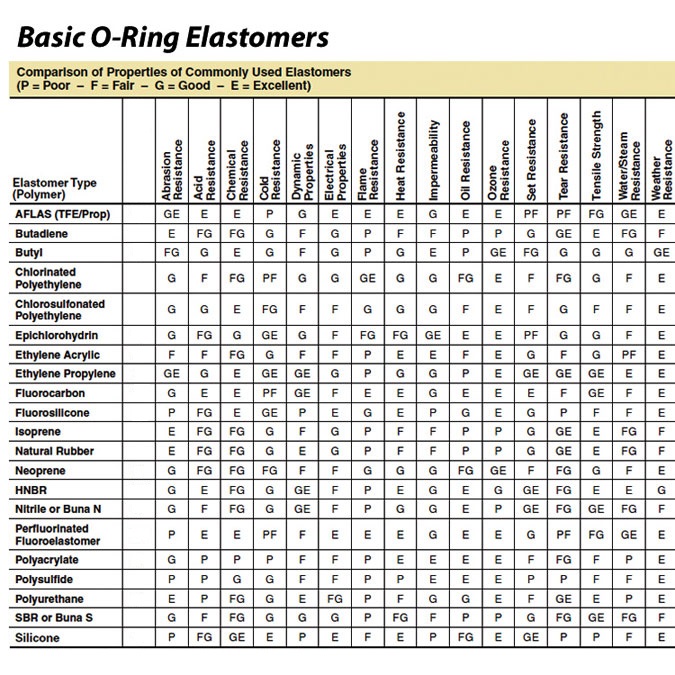O-ring Material Selection Guide
Flouroelastomer (FKM) Viton® O-rings
Viton® is an all-round material capable of handling a diverse array of applications, particularly sealing jobs involving movement. It is suited for silicone fluids and gases, petroleum oils, acids and some halogenated hydrocarbons. Viton® isn’t recommended for Skydrol, ethers with low molecular weight, amines, esters or hot hydrofluoric acids. Viton® O-rings are extremely versatile, finding a home in many chemical processing, automotive and appliance applications.
Flouroelastomer (FKM) [Brand Named: Viton®]
- 0ºF to 390ºF
- Suitable with: Petroleum Oils, Silicone Oils, Gasoline
- Cost Level: $$
Nitrile (Buna-N) O-rings
Nitrile or Buna-N O-rings produce general purpose seals that are tear-resistant and can withstand abrasive treatment. Nitrile O-rings, which have a temperature range between -54 and 149 degrees Celsius, are suitable for use with water, petroleum oils and some hydraulic fluids. Nitrile O-rings are not advisable for use with automotive brake fluid, ketones, phosphate ester hydraulic fluids, and nitro and halogenated hydrocarbons. Bear in mind that nitrile’s inherent ozone and weather resistance is not infallible, though it can be strengthened through compounding. Nitrile performs well in applications with limited temperature and resistance requirements, such as paintball markers.
Buna Nitrile (BN/NBR)
- -40ºF to 250ºF
- Suitable with: Aliphatic Hydrocarbons, Petroleum Oils, Gasoline, Hydraulic Oils, Diesel Fuel, Water
- Cost Level: $
Neoprene O-rings
Neoprene, which is classified as a general purpose elastomer, is unusual in that it is moderately resistant to petroleum oils and weather (ozone, UV, oxygen). Neoprene O-rings are therefore uniquely qualified for certain sealing applications where many other materials would fail. It has relatively low compression set, good resilience and abrasion, and is flex cracking resistant. Neoprene shares the same operational temperature range as nitrile and is commonly used to seal refrigerants in air conditioner and refrigeration units.
Neoprene (CR)
- -40ºF to 250ºF
- Suitable with: Ammonia, Refrigerants, Ozone
- Cost Level: $$
Silicone O-rings
Silicone O-rings perform well with water, steam or petroleum fluids and are sometimes used in high temperature fuel injection ports. They can operate within a temperature range of -84 and 232 degrees Celsius. Though silicone O-rings have been shown to withstand an extreme of -115 degrees Celsius during short periods of exposure. Silicone does, however, exhibit poor tear resistance, abrasion and tensile strength. It is therefore better suited for static, rather than dynamic, applications.
Silicone (VMQ)
- -90ºF to 430ºF
- Suitable with: Vegetable Oil, Water, Ozone
- Cost Level: $$
Ethylene Propylene Rubber (EPR) O-rings
Unlike Viton® O-rings, Ethylene Propylene Rubber (EPR) O-rings are suitable for use with corrosive Skydrol hydraulic fluid, as well as steam, water, silicone oils, brake fluids and alcohols. This material is known to display good heat and compression resistance. Similar to nitrile, EPR is not perfect for a wide-range of applications due to wear and tear issues. EPR O-rings have been used widely in the aerospace industry in hydraulic pumps.
Ethylene Propylene (EPDM)
- -60ºF to 300ºF
- Suitable with: Ammonia, Brake Fluids, Steam, UV
- Excellent weather resistance
- Cost Level: $
PTFE O-rings
PTFE encapsulated O-rings handle surface wear well, in addition to exhibiting corrosion and abrasion resistance, non-permeability, chemical inertness and low absorption. They can also operate within a wide temperature variance of between -73 and 260 degrees Celsius. Pure PTFE O-rings are very rigid and hard to apply, which makes them more suited to static applications. PTFE O-rings are often used in automotive industry steering devices and paint spray guns.
PTFE [Brand named: Teflon®]
- -150ºF to 530ºF
- Suitable with: Most Media
- Cost Level: $$$$
Polyurethane O-rings
Polyurethane is well regarded for its all-round general toughness, as well as for its notable abrasion and extrusion resistance. O-rings made from this material would not be suitable for applications requiring good compression and heat resistance. The latter is due to a narrower operational temperature range of between -54 and 100 degrees Celsius. Polyurethane O-rings are often used for hydraulics, cylinders, valves, pneumatic tools and firearms.
Polyurethane (PU)
- -40ºF to 195ºF
- Suitable with: Most Petroleum Oils
- Cost Level: $$

